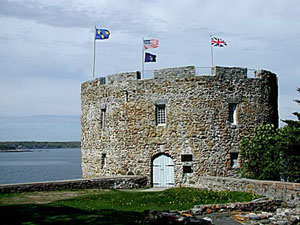Lineage - Tristram Dodge of Block Island
Israel Dodge: Caulkin's History of New London (Connecticut), page 32, says Israel was of the North Parish when he enlisted in the French War in the expedition against Cape Breton, March 1744-5.
Following their defeat by the British in 1713, and the loss of New Foundland and Nova Scotia, the French desired to defend their fortunes in Canada against further English incursions. France therefore spent millions in gold to build the 'impregnable fortress' of Louisbourg on Cape Breton Island at the mouth of the St. Lawrence.
This fortress menaced the New England fisheries and the Governor of Massachusetts Bay conceived a siege to capture the great Bastion. An army of New England militia made an amphibious landing in April, 1745 near Louisbourg.
Israel embarked in this army from New London on April 13, 1745, serving in the command of General Roger Wolcott.
Samuel Eliot Morrison, in his History of the American People, Page 158, relates the episode: (the forces) 'established a beachhead out of reach of the 150 gunned French fortress and conducted the campaign in a spirit of rustic frolic, defying both military discipline and principles of strategy. The Troops captured an outlaying battery from the rear, dragged artillery through supposedly impassable swamps, chased French cannonballs to shoot them back from their own guns and went fishing when they felt like it. ButÉ the net effect of their pluck and enterprise was to discourage and confuse the French commander of Louisbourg that on June 16, 1745 he surrendered both town and fortress.'
Three days after the surrender, on June 19 word was received in New London that Israel had fallen victim to disease. 'Having enlisted in the king's service to go to war,' he made his will March 16, 1744. Will filed Aug 13, 1745. He bequeathed to wife Rachel lands etc., while she remains his widow and to his children, mentioning the girls in the following order as 'first daughter,' 'second daughter,' etc., and calls his son Ezra his 'old son,' and Nehemiah his 'young son.'
Israel was the son of Israel Dodge and Hannah (last name unknown). He was the grandson of Tristram Dodge of Block Island.
